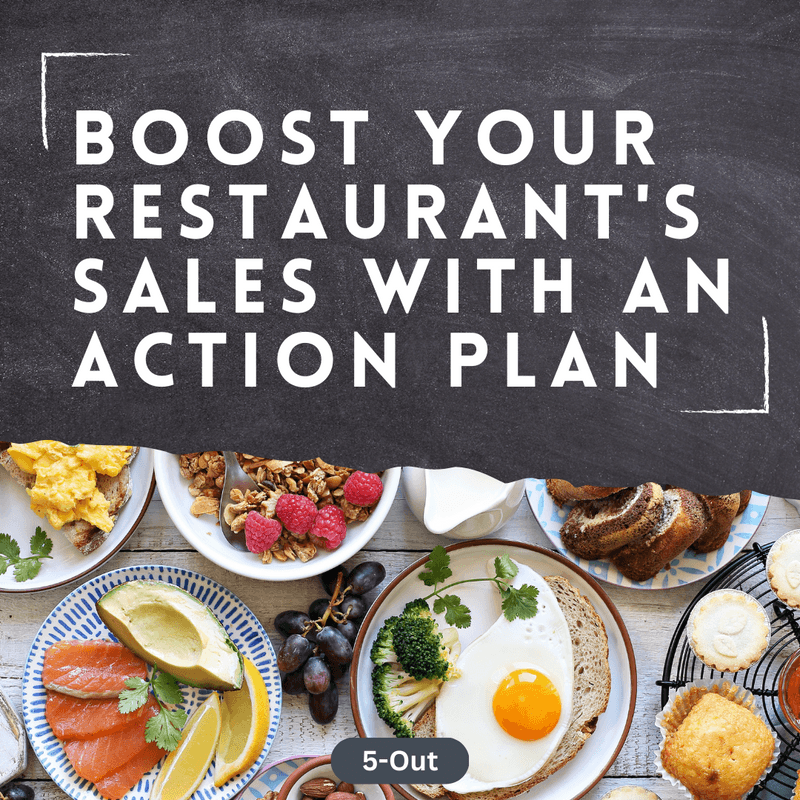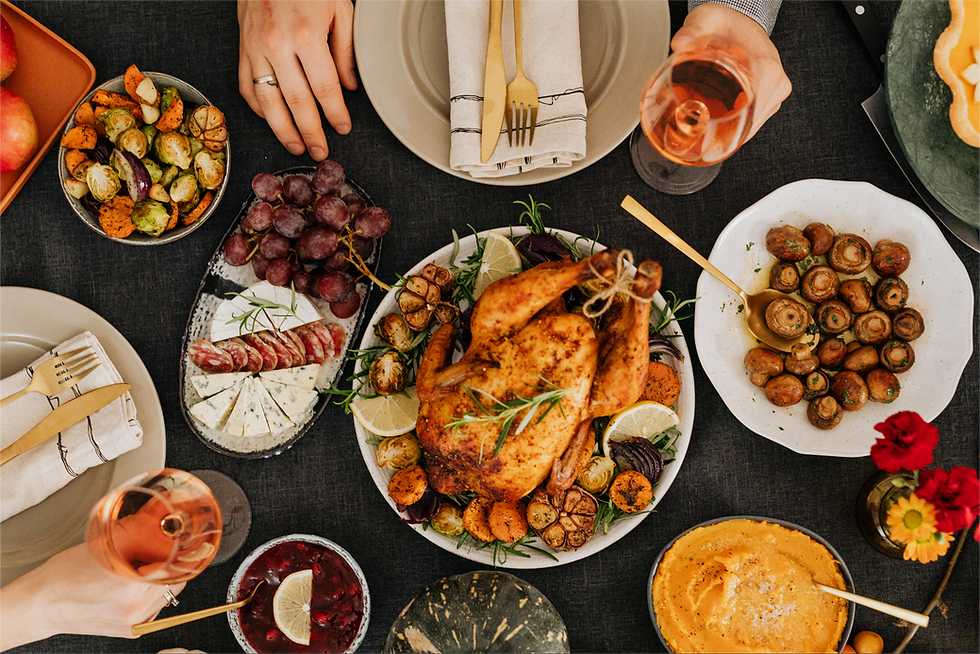How action plan to increase sales in a restaurant
- Michael Jones

- Apr 19, 2023
- 10 min read
Discover effective strategies to increase sales at your restaurant by implementing an action plan that focuses on analyzing sales performance, revamping the menu, enhancing the dining experience, marketing, optimizing pricing, and embracing technology. Adapt your action plan as needed to ensure continued success and growth.
Restaurant Management Revenue Optimization

In today's highly competitive restaurant industry, it is essential for successful restaurant owners to keep top of mind the need to increase sales in order to achieve success and growth in their establishment. With new restaurants popping up every day and customers' ever-changing preferences, it has become increasingly important to focus on ways to boost restaurant sales and stand out from the competition. A restaurant's sales not only determine its profitability, but also impact its ability to attract new customers, retain existing customers, and maintain a healthy cash flow.

What is an Action Plan?
An action plan is a systematic, step-by-step guide outlining specific strategies, tasks, and goals that need to be accomplished to achieve a desired outcome. It serves as a roadmap to help individuals or organizations identify and prioritize necessary actions, allocate resources, assign responsibilities, and set timelines for completion. A practical action plan enables clear communication of objectives, facilitates progress tracking, and ensures that all team members are working towards a common goal. In the context of increasing restaurant sales, an action plan would consist of various strategies and tactics aimed at boosting revenue, enhancing customer satisfaction, and improving overall restaurant business performance.
How Can an Action Plan Help to Increase Restaurant Sales?
An action plan can help increase restaurant sales by providing a clear and structured approach to addressing various aspects of the business that influence revenue generation. By implementing a well-thought-out action plan, restaurants can identify and prioritize key areas of improvement, streamline efforts, and optimize results.
1. Analyze Current Sales Performance
A comprehensive analysis of your restaurant's current sales performance is the foundation for developing an effective action plan and menu engineering. By understanding the existing state of your business, you can make informed decisions about the strategies and changes required to boost restaurant sales. Here's how to analyze your restaurant sales performance:
Assess Past Sales Data and Trends: Begin by reviewing your historical sales data, ideally over the past 12-24 months. This will provide you with valuable insights into your restaurant's sales patterns and customer behavior. Examine metrics such as average check size, total revenue, peak days and hours, and the most popular menu items. Look for trends, such as seasonal fluctuations or any sudden increases or decreases in restaurant sales. Understanding these patterns will help you make strategic decisions to maximize revenue during peak periods and minimize the impact of slow periods.
Identify Strengths and Weaknesses: Once you have a clear picture of your sales data, evaluate the strengths and weaknesses of your restaurant. Strengths could include a unique culinary offering, exceptional customer service, or a prime location. Weaknesses, on the other hand, might include outdated menu items, a lack of marketing efforts, or inefficient operations. Be honest with yourself when identifying these factors, as they will serve as the foundation for developing targeted strategies to improve your restaurant's sales performance.
Pinpoint Specific Areas for Improvement: With a thorough understanding of your sales data and an honest assessment of your strengths and weaknesses, identify specific areas that need improvement. For example, as a successful restaurant owner, if you notice that your lunch sales are lagging behind dinner sales, you might consider developing a special lunch menu or offering promotions to attract more lunchtime customers. Alternatively, if your data reveals that a particular menu item is consistently underperforming, it may be time to revamp or replace it. By pinpointing these specific areas, you can focus your efforts on implementing targeted strategies that will have the most significant impact on restaurant sales.

2. Revamp the Menu
One of the most effective ways to increase restaurant sales in a restaurant is by revamping the menu. A well-designed, appealing menu can entice customers to try new dishes, increase their average spending, and keep them coming back for more.
Optimize Menu Layout and Design: The layout and design of your menu play a crucial role in influencing customers' choices. Use principles of menu psychology to guide your design choices. For example, place your most profitable items in areas where customers' eyes naturally gravitate, such as the top right corner or the center of the page. Use clear, easy-to-read fonts, and avoid overcrowding the menu with too many items. Additionally, use high-quality images and descriptions to showcase your dishes and entice customers to order.
Implement a Seasonal Menu: Introducing a seasonal menu can help you take advantage of fresh, locally-sourced ingredients, which often results in better-tasting dishes and lower food costs. Seasonal menus also give customers a reason to visit your restaurant regularly, as they can look forward to trying new, limited-time dishes. By regularly updating your menu with seasonal offerings, you can create a sense of urgency for customers to visit before their favorite items are gone.
Introduce New and Innovative Dishes: To keep your menu fresh and exciting, consider introducing new and innovative dishes that cater to evolving customer tastes and preferences. Experiment with new flavors, ingredients, or cooking techniques to create unique dishes that set your restaurant apart from the competition. Consider emerging food trends and incorporate them into your menu where appropriate. This can help you attract new customers and pique the interest of your existing patrons.
Offer Limited-Time Promotions: Limited-time promotions, such as special discounts, bundled deals, or exclusive menu items, can create excitement around your restaurant and encourage customers to visit more often. Promotions can also help you upsell and cross-sell, increasing the average check size. For example, you might offer a discounted appetizer with the purchase of a main course, or a special dessert available only for a limited time. By regularly rotating your promotions, you can maintain customer interest and increase restaurant sales.

3. Enhance the Dining Experience
The overall dining experience plays a significant role in attracting and retaining customers, ultimately impacting your restaurant's sales. By focusing on creating a memorable and enjoyable experience, you can encourage repeat visits, positive word-of-mouth, and long-term customer loyalty, which are a part of customer relationship managment.
Improve Restaurant Ambiance: The ambiance of your restaurant can significantly influence a customer's perception of their dining experience. Pay attention to factors such as lighting, music, seating arrangement, and decor. Make sure your lighting is warm and inviting, and choose music that complements your restaurant's theme and style. Arrange to seat in a way that maximizes comfort and privacy, while also accommodating larger groups. Update your decor to create a cohesive theme that reflects your restaurant's brand identity.
Train Staff for Exceptional Customer Service: Exceptional customer service is a key differentiator in the competitive restaurant industry. Invest in regular training for your staff, ensuring they are knowledgeable about the menu, adept at upselling, and able to handle customer complaints with professionalism and grace. Encourage your staff to be attentive, friendly, and personable with customers, creating a welcoming atmosphere that encourages repeat visits. Remember that a well-trained, motivated staff is more likely to provide top-notch service, leading to increased customer satisfaction and more sales.
Offer unique dining options: Introducing unique dining options can help set your restaurant apart from the competition and create buzz among potential customers. Consider hosting themed nights, such as a "Taco Tuesday" or "Wine and Dine" evening, where customers can enjoy special menu items and promotions related to the theme. Alternatively, you could offer a chef's table experience, where customers can enjoy a curated, multi-course meal while interacting with the chef. By offering unique dining options, you can attract new customers, provide added value for your regular patrons, and ultimately increase restaurant sales.

4. Implement Effective Marketing Strategies
An essential component of increasing sales in your restaurant is implementing effective marketing campaigns that raise awareness, attract new customers, and encourage repeat visits. Here's how to leverage various marketing channels to boost sales:
Harness the Power of Social Media: Social media platforms such as Facebook, Instagram, and Twitter offer a cost-effective way to promote your restaurant and engage with customers. Create visually appealing content showcasing your dishes, share behind-the-scenes glimpses of your kitchen and staff, and post about upcoming promotions and special events. Engage with your audience by responding to comments and messages, and encourage customers to share their experiences by posting photos and reviews. Utilize targeted advertising to reach potential customers in your local area.
Collaborate with Local Influencers and Bloggers: Partnering with local food influencers and bloggers can help you reach a larger audience and generate buzz around your restaurant. Identify influencers whose followers align with your target demographic and offer them a complimentary meal or exclusive event in exchange for coverage on their social media channels or blogs. This kind of endorsement can lend credibility to your restaurant and encourage its followers to visit and try your dishes.
Offer Loyalty Programs and Special Deals: Loyalty programs and special deals can incentivize customers to visit your restaurant more frequently and increase customer lifetime value. Implement a loyalty program that rewards customers for repeat visits, such as a digital punch card or a points-based system. Offer exclusive deals, such as a percentage off their bill or a free appetizer, to customers who sign up for your email list or follow your social media presence accounts. These strategies can help you build a loyal customer base and drive sales growth.
Host Events and Partner with Local Businesses: Hosting events, such as wine tastings, live music nights, or cooking classes, can attract new customers to increase profits in a restaurant and create a lively atmosphere that encourages repeat visits. Partner with local companies, such as wineries, breweries, or farms, to co-host events or offer exclusive menu items featuring their products. Collaborating with other businesses not only expands your reach but also helps build a sense of community and strengthens your local network.
Utilize SEO: Boost your online visibility using Search Engine Optimization (SEO) by incorporating relevant keywords into your website content, such as your cuisine type and location. Regularly updating your site with engaging content like blog posts can also improve your SEO ranking. List your restaurant on Google My Business, ensuring accurate business name, location, and operating hours. Encourage customer reviews here, as these can enhance your restaurant's reputation. Always respond to reviews to show you value feedback. Regularly update and monitor your SEO and Google My Business to keep attracting potential customers.

5. Optimize Pricing Strategies
An effective pricing strategy is crucial for maximizing sales and profitability in your restaurant. By optimizing your pricing, you can find the right balance between attracting customers and maintaining healthy profit margins. Here's how to optimize your pricing strategies:
Employ Psychological Pricing Techniques: Psychological pricing techniques can help you tap into customers' perceptions of value and encourage them to make a purchase. One common approach is to use charm pricing, which involves setting prices just below whole numbers (e.g., $9.99 instead of $10). This creates the perception that the item is more affordable than it actually is. Another technique is to offer a premium option alongside a standard option, making the standard option appear to be a better deal. Experiment with various psychological pricing strategies to see which resonates best with your customers and increase restaurant sales.
Monitor Competitor Pricing: Keeping an eye on your competitors' pricing can help you stay competitive and ensure that your restaurant's offerings are perceived as good value. Regularly research the prices of similar dishes at competing restaurants and adjust your own pricing accordingly. Be mindful not to engage in a price war, as this can lead to reduced profit margins and may not result in increased sales. Instead, focus on offering unique value propositions that justify your pricing, such as exceptional quality, innovative dishes, or a superior dining experience.
Offer Value-Added Packages and Bundles: Value-added packages and bundles can help you increase the perceived value of your offerings while encouraging customers to spend more. For example, you might offer a prix fixe menu that includes an appetizer, main course, and dessert for a fixed price, giving customers the impression of a better deal than ordering a la carte. Alternatively, you could offer a discounted beverage or dessert with the purchase of a main course. These packages and bundles not only provide customers with a sense of value but also encourage them to try a wider variety of dishes, which can lead to higher overall sales.

6. Embrace Technology
In today's rapidly evolving business landscape, embracing technology can give your restaurant a competitive edge and help you streamline operations, enhance the customer experience, and make data-driven decisions. Here's how to leverage technology to boost your restaurant's sales:
Implement Online ordering and Reservation Systems: An online ordering system and reservation system can improve the customer experience by making it more convenient for patrons to place orders or book tables. These systems can also help you capture valuable customer data, such as contact information, order history, and preferences, which can be used to tailor your marketing efforts and improve customer retention. By offering a seamless, user-friendly experience, you can encourage more customers to order from your restaurant or book reservations, ultimately increasing sales.
Incorporate Food Delivery Services: In today's world where convenience is key, offering food delivery can significantly boost your restaurant's sales. By partnering with popular food delivery apps, you can expand your reach beyond the local area and tap into a larger customer base. These services can also cater to the needs of customers who prefer eating at home or those with busy schedules. Additionally, food delivery can help increase order volume during off-peak hours. Be sure to keep your delivery menu up-to-date and consider offering delivery-specific promotions to encourage more orders. Remember to balance this with maintaining an excellent in-house dining experience for customers who prefer that option.
Utilize Data Analytics to Make Informed Decisions: Data analytics tools can help you gain insights into your restaurant's performance, customer behavior, and market trends. By analyzing data such as sales patterns, customer demographics, and menu item performance, you can make informed decisions about your menu offerings, pricing strategies, and marketing campaigns. These insights can help you optimize your operations, identify growth opportunities, and improve your overall sales performance.
Adopt Digital Marketing Tools: Digital marketing tools, such as email marketing platforms, social media management tools, and web analytics software, can help you track the effectiveness of your marketing campaigns and make data-driven adjustments. By measuring key performance indicators (KPIs) such as click-through rates, conversion rates, and return on investment (ROI), you can determine which marketing tactics are working best and allocate resources accordingly. This data-driven approach can help you maximize the impact of your marketing efforts and drive sales growth.
Leverage Sales Forecasting Software: Sales forecasting software, such as 5-Out, can help you predict future sales patterns, enabling you to make informed decisions about labor scheduling and inventory management. By accurately forecasting demand, you can ensure that you have enough staff on hand to provide excellent service during peak periods and minimize labor costs during slower times. Similarly, effective inventory management can help you reduce food waste and ensure that you have the necessary ingredients on hand to meet customer demand. By optimizing these aspects of your operations, you can improve your restaurant's efficiency and profitability, ultimately leading to increased sales.
Request a demo to see how sales forecasting software can help to increase your restaurant sales!



Comments